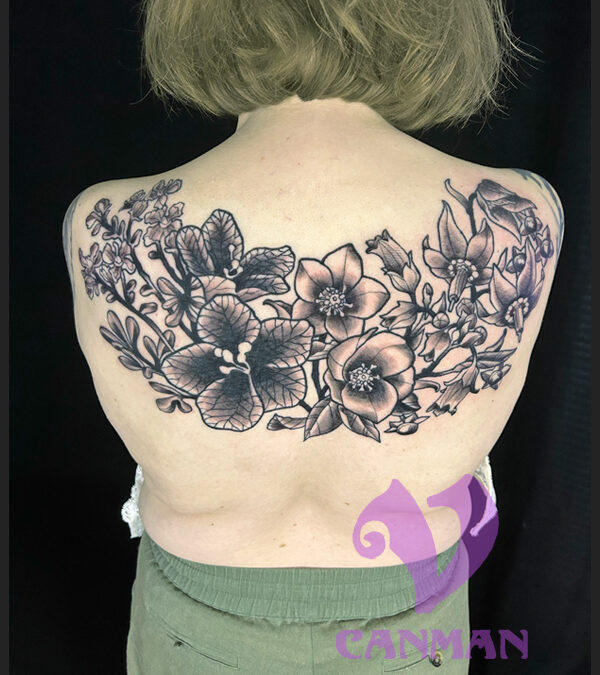Canman tattooed this Poisonous flowers tattoo in Black and grey.
The client is a collector of poison flowers.
Her collection includes Belladonna,Rue, Henbane and hellebore.
Are you wanting flower with a darker vibe?
Get your tattoo project started on our Tattoo Request Form.
About poisonous flowers
Firstly, Poisonous flowers are a fascinating yet dangerous aspect of nature’s beauty.
Their vibrant colors and delicate petals can be alluring.
Subsequently, many of these flowers harbor toxic compounds.
Secondly, the compounds can be harmful or even lethal to humans and animals.
A few deadly beauties
Oleander is an ornamental plant known for its stunning clusters of white, pink, red, or yellow flowers.
Despite its beauty, every part of the oleander plant is extremely toxic.
Oleander contains cardiac glycosides, which can cause serious heart problems, including arrhythmias, and gastrointestinal issues if ingested.
Consequently, symptoms of oleander poisoning include nausea, vomiting, abdominal pain, and an irregular heartbeat.
Safety Tips
- Always wear gloves when handling oleander.
- Keep oleander plants out of reach of children and pets.
- Avoid burning oleander trimmings, as inhaling the smoke can be harmful.
Foxglove is easily recognizable by its tall spikes of tubular flowers, which can be purple, pink, white, or yellow.
Gardens and woodlands is where foxglove is found.
Foxglove contains digitalis, a compound used in heart medication but highly toxic in uncontrolled doses.
Ingesting any part of the plant can lead to symptoms such as nausea, vomiting, diarrhea, and severe heart issues.
Safety Tips
- Do not plant foxglove in areas accessible to children or pets.
- Educate family members about the dangers of this plant.
- Use gloves when gardening around foxglove.
Lily of the Valley is a charming plant with delicate, bell-shaped white flowers and a sweet fragrance.
It is often used in wedding bouquets and garden borders.
Also, this plant contains cardiac glycosides similar to those found in oleander and foxglove.
Symptoms of poisoning include dizziness, nausea, vomiting, and heart irregularities.
Safety Tips
- Avoid ingesting any part of the plant.
- Wash hands thoroughly after handling.
- Keep away from children and pets.
Rhododendrons are popular garden shrubs known for their large, showy clusters of flowers.
In addition, comes in a variety of colors.
All parts of the rhododendron plant contain grayanotoxins.
As a result, can cause nausea, vomiting, difficulty breathing, and even coma in severe cases.
Safety Tips
- Plant rhododendrons in areas where children and pets cannot access them.
- Wear protective clothing when handling the plant.
- Do not use rhododendron trimmings as mulch.
The autumn crocus blooms in the fall with beautiful purple, pink, or white flowers.
It is often mistaken for the harmless spring crocus.
Autumn crocus contains colchicine.
A potent toxin that can cause severe gastrointestinal distress, organ damage, and can be fatal if ingested.
Safety Tips
- Clearly label autumn crocus plants in your garden.
- Educate others about the differences between autumn and spring crocuses.
- Wear gloves when handling this plant.
Conclusion
In conclusion, poisonous flowers can add beauty and charm to gardens and landscapes.
It is crucial to handle them with care and respect.
Understanding the risks and take appropriate safety measures.
Therefore, you can enjoy these plants while minimizing the danger they pose.
Always educate yourself and others about the toxic nature of these flowers.
keep them out of reach of children and pets to ensure a safe and beautiful garden environment.
A Poisonous flowers tattoo can be a cool and cautionary design to add to your collection.
FAQs
Q: Are all parts of these plants poisonous?
A: Yes, in most cases, all parts of these plants are toxic. This includes flowers, leaves, stems, and sometimes even the roots.
Q: Can touching these plants cause harm?
A: While touching these plants usually does not cause severe harm, it is still recommended to wear gloves to avoid skin irritation and accidental ingestion of toxins.
Q: What should I do if someone ingests a poisonous flower?
A: Seek immediate medical attention or contact a poison control center. Do not induce vomiting unless instructed by a professional.
